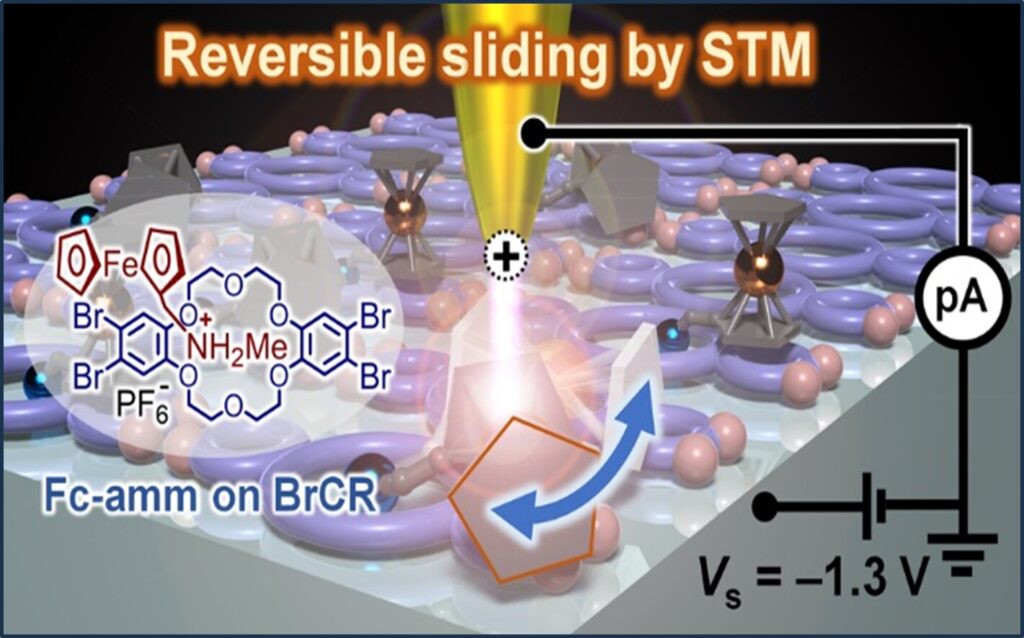Artificial molecular machines, nanoscale machines consisting of a few molecules, offer the potential to transform fields involving catalysts, molecular electronics, medicines, and quantum materials. These machines operate by converting external stimuli, like electrical signals, into mechanical motion at the molecular level.
Ferrocene, a special drum-shaped molecule composed of an iron (Fe) atom sandwiched between two five-membered carbon rings, is a promising foundational molecule for molecular machinery. Its discovery earned the Nobel Prize in Chemistry in 1973, and it has since become a cornerstone in the study of molecular machines.
What makes ferrocene so appealing is its unique property: A change in the electronic state of the Fe ion, from Fe2+ to Fe3+ causes its two carbon rings to rotate by about 36° around the central molecular axis. Controlling this electronic state by an external electrical signal could enable precisely controlled molecular rotation.
However, a major hurdle in its practical application is that it readily decomposes when adsorbed onto the surface of substrates, especially flat noble metal substrates, near room temperature, even under ultra-high vacuum conditions. A definitive method for anchoring isolated ferrocene molecules on a surface without decomposition has not been found, until now.
In a groundbreaking study, a research team led by Associate Professor Toyo Kazu Yamada from the Graduate School of Engineering at Chiba University, Japan, including Professor Peter Krüger from the Faculty of Engineering at Chiba University, Professor Satoshi Kera of the Institute for Molecular Science, Japan, and Professor Masaki Horie of National Tsing Hua University, Taiwan, has finally overcome this challenge. They have successfully created the world’s smallest electrically controlled molecular machine.
“In this study, we successfully stabilized and adsorbed ferrocene molecules onto a noble metal surface by pre-coating it with a two-dimensional crown ether molecular film. This is the first direct experimental evidence of ferrocene-based molecular motion at the atomic scale,” said Prof. Yamada.
Their findings were published in the journal Small on November 30, 2024.
To stabilize the ferrocene molecules, the team first modified them by adding ammonium salts, forming ferrocene ammonium salts (Fc-amm). This improved durability and ensured that the molecules could be securely fixed to the surface of the substrate.
These new molecules were then anchored onto a monolayer film made up of crown ether cyclic molecules, which were placed on a flat copper substrate. Crown ether cyclic molecules have a unique structure with a central ring that can hold a variety of atoms, molecules, and ions.
Prof. Yamada explains, “Previously, we found that crown ether cyclic molecules can form a monolayer film on flat metal substrates. This monolayer traps the ammonium ions of Fc-amm molecules in the central ring of crown ether molecules, preventing the decomposition of ferrocene by acting as a shield against the metal substrate.”
Next, the team placed a scanning tunneling microscopy (STM) probe on top of the Fc-amm molecule and applied an electrical voltage, which caused a lateral sliding motion of the molecules. Specifically, on applying a voltage of −1.3 volts, a hole (vacant space left by an electron) enters the electronic structure of the Fe ion, switching it from Fe2+ to Fe3+ state.
This triggered the rotation of the carbon rings accompanied by a lateral sliding motion of the molecule. Density functional theory calculations showed that this lateral sliding motion occurs due to the Coulomb repulsion between the positively charged Fc-amm ions.
Importantly, on removing the voltage, the molecule returns to its original position, demonstrating that the motion is reversible and can be precisely controlled using electrical signals.
“This study opens exciting possibilities for ferrocene-based molecular machinery. Their ability to perform specialized tasks at the molecular level can lead to revolutionary innovations across many scientific and industrial fields, including precision medicine, smart materials, and advanced manufacturing,” says Prof. Yamada.


